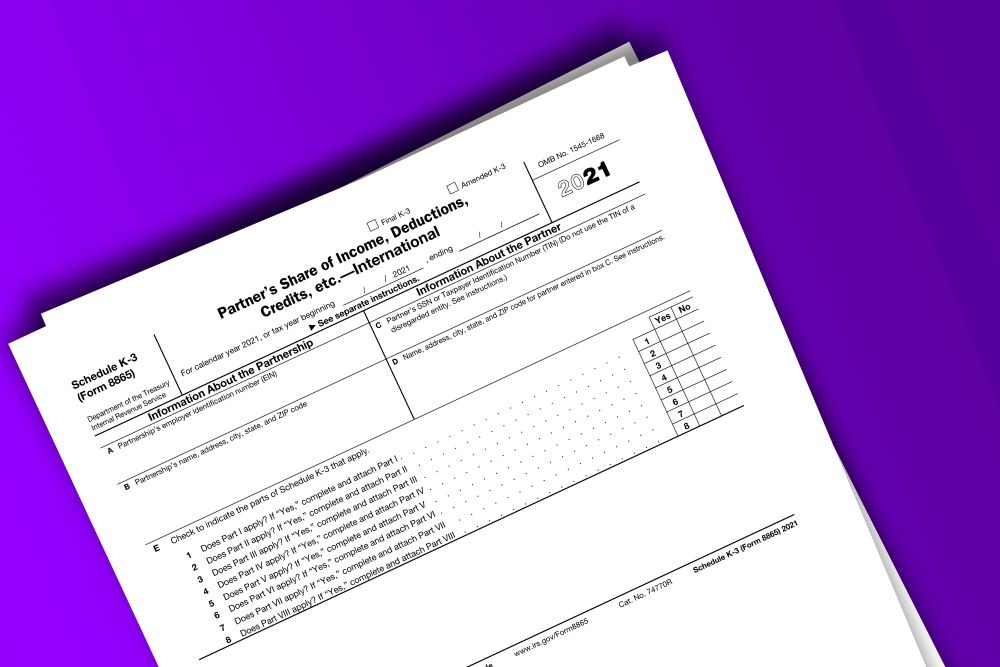Domestic Filing Exception for Partnerships Updated

When a business generates income from foreign sources, retains an interest in a foreign company, or has a foreign tax interest, additional IRS filings must be filed. This is especially true for pass-through entities (PTEs) such as partnerships, S-corporations, or limited liability companies (LLCs). Specifically, these companies are required to file Schedule K-2 and K-3. The K-2 supplements the main tax return with information about items of international tax relevance, while the K-3 outlines each partner’s distributive share of the international tax. Traditionally, those without international tax considerations simply did not file due to the domestic filing exception.
However, an update issued in 2021 led many to make a filing even when they did not have eligible activities. This placed an undue burden on smaller companies with limited resources. The good news is the IRS recently issued a new directive relaxing the requirements to claim the filing exception. To help clients, prospects, and others, Klatzkin has provided a summary of the key details below.
Background on Domestic Filing Exception for Partnerships
Most partnerships are required to file Form 1065 with additional forms and schedules that may be required depending on the partnership’s – or the individual partner’s – tax exposure. Failure to file all required information can result in penalties, specifically related to Schedules K-2 and K-3.
The Tax Cuts and Jobs Act added new filing requirements for partnerships related to Schedules K-2 and K-3, which are used to report individual partners’ distributive shares of foreign tax items. The revised Schedules required more information to calculate tax liability. These Schedules must be filed with the entity’s annual income tax return.
Historically, Schedules K-2 and K-3 weren’t required if the partnership didn’t have significant foreign tax interests. That changed in the 2021 tax year. As of last year, PTEs have been required to report any significant and relevant foreign tax items. Further, interests in foreign tax items were to be detailed on Schedule K-3 and distributed to partners.
While most interpretations of this change were that only partnerships with foreign tax interests were required to issue Schedules K-2 and K-3, in practice most still had to comply with the extra requirements. This caused a potentially significant reporting burden for small and mid-size partnerships, especially those with minimal foreign tax interests.
In updated filing instructions, the IRS states: “A partnership with no foreign source income, no assets generating foreign source income, no foreign partners, and no foreign taxes paid or accrued may still need to report information on Schedules K-2 and K-3. … Also, a partnership that has only domestic partners may still be required to complete Part IX when the partnership makes certain deductible payments to foreign related parties of its domestic partners.”
October 2022 Guidance – Certain Filing Exceptions
In October, the IRS included a new domestic filing exception to exempt partnerships and S-corporations from providing schedules for tax years starting in 2022. A similar exception was also included in 2021 Schedule K instructions.
The exception provided exempted taxpayers from providing extra forms if all the following requirements are met:
- No or limited foreign activity.
- All direct partners are U.S. citizens or resident aliens.
- Partners must receive a notification by January 15, 2023, that they will not receive Schedule K-3 unless specifically requested.
- The partnership does not receive any such requests until one month before the due date for Form 1065.
Foreign activity is defined as any of the following:
- Foreign income taxes paid or accrued.
- Foreign source income or loss.
- Ownership interest in a foreign partnership, corporation, or foreign branch, or foreign entity is treated as a disregarded entity separate from its owner.
December 2022 – Filing Exception Updates
While the new instructions contain the same four requirements in the October 2022 guidance, details have been updated, including:
- Allowable direct partners can also be S-corporations with a single shareholder and certain single-member LLCs that are disregarded entities from the owner.
- The partner notification has been extended to the date when the partnership issues Schedule K-1; the notice can be an attachment to Schedule K-1.
- The partnership also has extra time to receive partner requests for Schedule K-3 to one month before the partnership files Form 1065.
The updated instructions give partnerships extra time to comply with the domestic filing exception. So, while the burden is still on the entity to comply with the reporting requirements, it will be somewhat easier to issue any required tax forms.
If a partnership receives a notice from a partner requesting Schedule K-3 information after the one-month date has passed, and no other partner requests have been made, the domestic filing exception is still valid. The partnership still must provide that partner with the relevant Schedule K-3 information according to Requirement 4, stated above.
Further Guidance Needed
It may be possible in future tax years for individuals to bear the responsibility of notifying the partnership of any foreign tax interests – not the other way around. It could also be that partners would need to notify the partnership of which parts of Schedule K-3 they require. The AICPA recommends these changes, but yet, they are not included in current tax form instructions.
Contact Us
Whenever international interests are involved, it often complicates the company’s annual tax filings. However, the recently issued domestic filing exception guidance provides important clarification on when K-2 and K-3 filings are not required. If you have questions about the information outlined above or need assistance with a tax or accounting issue, Klatzkin can help. For additional information call 609-890-9189 or click here to contact us. We look forward to speaking with you soon.
©2022 Klatzkin & Company LLP. The above represents our best understanding and interpretation of the material covered as of this post’s date and should not be construed as accounting, tax, or financial advice. Please consult your tax advisor concerning your specific situation.
